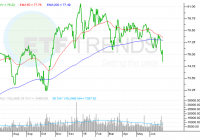VYM: A Quality Dividend Growing ETF
Summary Features great dividend growth and diversification across sectors. Traditional low Vanguard expense fees keep your costs down. Lags, though closely follows the S&P for total return. Fund 10% down for the year creates a buying opportunity. Solid ETF choice to balance with SCHD for long-term income generation. Introduction The Vanguard High Dividend Yield ETF (NYSEARCA: VYM ) is a quality ETF by Vanguard, the leader in low-cost ETFs. The fund tracks the FTSE High Dividend Yield Index which tracks stocks that are forecasted to have above-average dividend yields. The fund applies no type of quality metric or additional screening to the companies. It also excludes REITs. It currently has 434 holdings and carries an expense ratio of 0.10%. The Holdings VYM holds a wider variety of stocks than the Schwab U.S. Dividend Equity ETF ( SCHD), which I wrote about in another article . (click to enlarge) To compare, both funds are light on materials while SCHD is also very light on utilities, financials and telecommunications. A few basic stats, the top 10 holdings make up 30% of VYM, 42% of SCHD, and the top 25 makes up 58% of VYM vs. 74% for SCHD. Dividend Growth VYM has also featured great dividend growth the last several years. We need to see what the December dividend is, but using the trailing 12-month period (last raise announced 9/23/15), it grew 12.4% this past year, and has a 3-year average of 12.7%. Performance Inception to-date performance vs. the S&P has slightly lagged as mentioned in the summary. This return is assuming all dividends reinvested. Data courtesy of DividendChannel. (click to enlarge) I like to compare this with SCHD’s inception to-date results to get a closer apples-to-apples comparison of a dividend based ETF. (click to enlarge) SCHD has lagged VYM since its inception by a percentage point each year. One other comparison point between VYM and SCHD is looking at their top holdings. Since their top holdings make up the majority of the funds, it’s important to see how they are similar and where they differ. This information may help an investor decide which fund to buy into (if it’s an either/or scenario) based on the business prospects of a company(ies) that may be absent from a fund. The green colors mean the company is contained within both funds, red means that one is not contained within the other (for example Wells Fargo (NYSE: WFC ) and AT&T (NYSE: T ) are not in SCHD) and yellow denotes they are in the other fund, just not the top 30. Why Now? The market has been off its highs in 2015 as there are now several factors weighing on the market. Looking at the past 5 years, the yield has never been higher. It briefly touched over 3% during the corrections of 2011 and 2013, but has sustained 3%+ for the last few months of 2015. This offers a historically good entry point. The sharp rally of the past week has pushed the yield down however from approximately 3.42% to 3.25%. VYM data by YCharts Conclusion VYM is another great ETF product by Vanguard. The fund has had a solid track record of performance, delivering growing dividends while closely following the performance of the S&P 500. The yield is still over a percentage point higher than the S&P for investors focusing on generating more income while still delivering great total return. I like the prospects of both VYM and SCHD and think they can be compared to one another whether adding to an existing or opening a new position.
